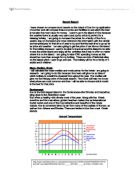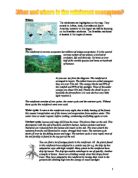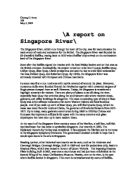Areas that were once peninsulas become islands and glaciers retreating at an incredible rate of very few years. Temperatures have increased since 1950 11ºF in winter thats the largest temperature increase ever recorded any where on earth, making it the frontline of large temperature changes.
Half the year in Antarctica is darkness and the other half is daylight.
The climate is described by it’s below freezing temperature, some of the highest wind speeds and the occasional blizzard. The weather is changing rapidly alone the coast, where the temperatures for even the warmest of months still average around freezing. The temperature in winter minimums as low as -40ºC. Continuos darkness along with high altitude in winter unite to make Antarctica the coldest place on the planet. Summer temperatures don’t usually get warmer than -18ºC.
Antarctica is known through out the globe for it’s extreme katabatic winds and blinding storms. It’s built up a reputation to be the windiest most hostile area on earth and it’s well deserved. Ever present danger curses the continent. For example blizzards and temperatures appose a devastating threat to your very existence. The highest windspeed ever recorded in Antarctica were 327km/h, this windspeed is equal to the entire worlds wind speed at 327km/h in Ne Hampshire, Mount Washington. The highest temperature ever recorded in Antarctica was 14.6ºC and the lowest ever recorded was -89.2ºC.
Because Antarctica lies on a very low latitude it only receives sun for half a year. Because Earth revolves around the sun and Antarctica lies on a very low latitude barely any sun is shun upon it, which is one of the reasons for it’s extreme temperatures.
Location and Purpose of Mawson Station:
Mawson Station is located on East Antarctica. Mawson Station experiences polar climate, so it is very cold and dry. This makes it a icy desert. It experiences katabatic winds which include draining of cold air down steep slopes from the ice sheet from the higher area of interior of the continent. The annual speed of the winds on the East travel at roughly 40km/h but every once a a while the winds exceed up to 240km/h. Mawson Station experiences very little sun throughout the year and when the sun rises over the Arctic circle Mawson Stations remains blind for another 6 weeks during June and July. Because of Antarctica's low latitude, it makes it hard for sun ray’s to reach it so less heat is distributed there. The temperature during the year drops from January and is at it’s lowest in August but then begins to rise again towards December. I believe the area that Mawson Station has been built on was likely chosen because it is easy accessible from boats, being on the coast.. Also the location of Mawson Station provided excellent access to the interior of the continent.
There are many scientific key programs and buildings at Mawson Station. Buildings such as the cosmic ray observatory contain telescopes, which can detect and measure cosmic rays coming from outside the solar system. There is a sunshine recorder, which is an old instrument used to measure the ours of sunshine antarctica is exposed to. “This instrument focusses the suns rays through a glass sphere that burns a track onto a card with the sun’s apparent movement across the sky.” (AAD 2011, p. 1).
It is important that these stations are maintained because without these stations we would not be able to know the effects of climate change on the polar region and without these stations scientists couldn’t study arctic animals/ creatures on the bottom of the food chain, to better to understand the environmental impact of humans on the Arctic animals. “Mawson Research Station is a base for scientific research programs including an underground cosmic ray detector, various long-term meteorological aeronomy and geomagnetic studies, as well as ongoing conversation biology studies, in particular of nearby Auster rookery, a breeding ground for Emperor and Adelie Penguins.” (Scott, Keith 1993, p. 29-31)
Pollution is an ongoing problem occurring all over the world. It slowly has become the most catastrophic global problem. Pollution is the main cause of global warming and if something it not done about it soon the effects of it will take a toll on Antarctica’s wild life. Oil spills are becoming more and more common in Antarctica’s waters. The cause of more oil spills is simple, the increasing of shipping activity. There isn’t really an easy way to prevent oil spills. If there was a way it would have to be to leave the oil in the ground in the first place, which is most likely not going to happen. If an easier solution is not thought of the ozone layer in Antarctica will become more an more unstable to support life.
Mawson Station:
Mawson Station is one of many research stations. It has been built on a rock formation on the edge of the Antarctic plateau. Mawson station is managed and was built buy the Australian Antarctic Division (AAD). It was named after Sir Douglas Mawson, Antarctic explorer.“It is Australia’s first continental station and the longest continuously operating station south of the Antarctic Circle.” (Antarctica.gov.au 2011, Mawson Station).
Antarctica is approximately 7,014 kilometers from Australia. It would take roughly 8 hours and 43 minutes on a plane to travel from Australia to Antarctica if traveling at 500mph. The nearest city in Australia to Antarctica. The closest large city (200,000 or more) is Hobart. It is 3,575 miles or 5,754 kilometers from Antarctica.
There are many permanent research stations. In fact there are 23 permanent stations, though one is shared by both Italy and France. A number of countries maintain these permanent research stations All the research stations have been erected on rock or ice that has been fixed in place. Ukraine have built one, USA own 4 different stations, Uruguay have built one, Argentina have the most. They have built 6 different stations. Russia have 4 stations as well as Chile and India, Australia has 3 stations, Brazil have one, France and Italy share one, Japan have two, so does china and the UK. Poland have one, South Korea as well. Germany have two. Pakistan have recently build one, Belgium also have built one quite recently. South Africa, Bulgaria, New Zealand and Norway all each have one station.
It is important that these stations are maintained because without these stations we would not be able to know the effects of climate change on the polar region and without these stations scientists couldn’t study arctic animals/ creatures on the bottom of the food chain, to better to understand the environmental impact of humans on the Arctic animals. “Mawson Research Station is a base for scientific research programs including an underground cosmic ray detector, various long-term meteorological aeronomy and geomagnetic studies, as well as ongoing conversation biology studies, in particular of nearby Auster rookery, a breeding ground for Emperor and Adelie Penguins.” (Scott, Keith 1993, p. 29-31)
Mawson Station is located on East Antarctica. Mawson Station experiences polar climate, so it is very cold and dry. This makes it a icy desert. It experiences katabatic winds which include draining of cold air down steep slopes from the ice sheet from the higher area of interior of the continent. The annual speed of the winds on the East travel at roughly 40km/h but every once a a while the winds exceed up to 240km/h. Mawson Station experiences very little sun throughout the year and when the sun rises over the Arctic circle Mawson Stations remains blind for another 6 weeks during June and July. Because of Antarctica's low latitude, it makes it hard for sun ray’s to reach it so less heat is distributed there. The temperature during the year drops from January and is at it’s lowest in August but then begins to rise again towards December.
Mawson Station have been using Volkswagen Beetles to travel on ground though poor quality roads limit land transportation. The roads are disturbed by constant winds blowing snow onto them and can not with stand the sever weather. There is only one harbor on Antarctica, located at McMurdo Station, the US research station. Most of the stations on Antarctica have there own offshore anchorages. Most of the transport taken place on Antarctica is using airplanes and helicopters. There are 20 airports on Antarctica and none of them are accessible to the public. In Mawson Station there is a helicopter pad though it is rarely used.
I believe the area that Mawson Station has been built on was likely chosen because it is easy accessible from boats, being on the coast. Also the location of Mawson Station provided excellent access to the interior of the continent.
There are many scientific key programs and buildings at Mawson Station. Buildings such as the cosmic ray observatory contain telescopes, which can detect and measure cosmic rays coming from outside the solar system. There is a sunshine recorder, which is an old instrument used to measure the ours of sunshine antarctica is exposed to. “This instrument focusses the suns rays through a glass sphere that burns a track onto a card with the sun’s apparent movement across the sky.” (AAD 2011, p. 1).
Human Adaption:
Most of the equipment used in the past is still being used today except in terms of insulation and durable the more modern equipment has been proved much better. For example the old snow boots that used to be used did not have the same safety standards as the boots today. The old boots weren’t well insulated and weren’t as adapt to wet conditions but today modern snow boots are very thick and tight protecting your feet from brutally cold conditions. If this change was not made the people working in Antarctica may have suffered the same diseases that the people in the earlier years did. In 1966 the safety standers weren’t as strict and therefor there were consequences. People were diagnosed with Peripheral neuropathy and Raynauds phenomenon.
Peripheral neuropathy is the result of skin exposed to cold. It is acquired by a injury to the nervous system which can be caused by freezing temperatures. If diagnosed with this it can quickly lead to severe damage to the nerve system or even death. Raynauds phenomenon. Raynauds phenomenon is also caused by exposure to the cold. It restricts the blood flow in your body. Raynauds phenomenon is not as life threatening in most cases it is harmless but in sever cases it can permanently damage tissue.
This is why is is so important that more clothing is worn and all clothing is well insulated and water resident because without these simple safety features it can result in diseases and even death. As you can see a lot more medical equipment is used today after dealing with disease in Antarctica.
Animal Adaption:
Being an Emperor penguin in Antarctica, male or female, is tough. You have to survive the freezing temperatures while raising a chick. When the egg is created the females head out to sea to collect food for the chick when it hatches. The male is left in the breeding grounds alone with the chick. This puts the male penguin in a very difficult position it will be a few months before he can eat and he has to take care of his egg.
Behavioral Adaptions:
The Emperor penguin crowds together with other Emperor penguins to keep warm. They form one huge pack and take turns standing on the outside and in the middle. Because otherwise only the penguins in the middle would survive while the others are blown away and frozen by the wind. The Emperor penguins breed during Winter so the chicks are large enough to become independent during the summer abundance of food.
Physical adaptions
Emperor penguins have four layers of scale-like feathers. This forms a good protection from wind. Emperor penguins also have a thick layer of fat. These layers of fat act as insulation keeping the penguin warm.
Conclusion:
Antarctica is a unique place because there is no other place like it on Earth. It is very peaceful and cut off from the rest of the world. One day lasts half a year and the night lasts the other half. Some of the rarest endangered species accept Antarctica as their home. However there are no land animals: mammals, reptiles and amphibians. There are several species of penguins, fish, birds, seals, squid and whales in Antarctica that can be found no where else in the world.
This magical, mythical island has been free from man’s destructiveness until now. Over the last few years the planet is becoming more and more polluted and global warming is taking a toll on the innocent land of Antarctica. If we do not act now it may be to late to save Antarctica and it will perish. The Antarctic species numbers already are slowly diminishing. Most of the animals in Antarctica now are endangered because we don’t act. We need to stop global warming before it stops us.








